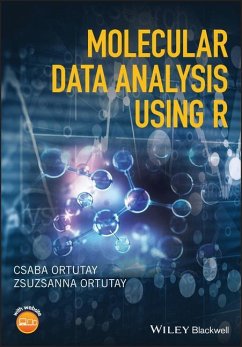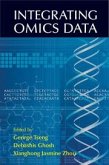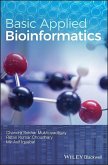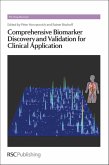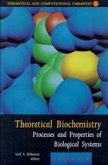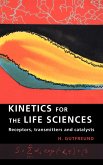- Broschiertes Buch
- Merkliste
- Auf die Merkliste
- Bewerten Bewerten
- Teilen
- Produkt teilen
- Produkterinnerung
- Produkterinnerung
This book addresses the difficulties experienced by wet lab researchers with the statistical analysis of molecular biology related data. The authors explain how to use R and Bioconductor for the analysis of experimental data in the field of molecular biology. The content is based upon two university courses for bioinformatics and experimental biology students (Biological Data Analysis with R and High-throughput Data Analysis with R). The material is divided into chapters based upon the experimental methods used in the laboratories. Key features include: * Broad appeal--the authors target their…mehr
Andere Kunden interessierten sich auch für
![Integrating Omics Data Integrating Omics Data]() George TsengIntegrating Omics Data133,99 €
George TsengIntegrating Omics Data133,99 €![Basic Applied Bioinformatics Basic Applied Bioinformatics]() Chandra Sekhar MukhopadhyayBasic Applied Bioinformatics142,99 €
Chandra Sekhar MukhopadhyayBasic Applied Bioinformatics142,99 €![Comprehensive Biomarker Discovery and Validation for Clinical Application Comprehensive Biomarker Discovery and Validation for Clinical Application]() Comprehensive Biomarker Discovery and Validation for Clinical Application235,99 €
Comprehensive Biomarker Discovery and Validation for Clinical Application235,99 €![Theoretical Biochemistry Theoretical Biochemistry]() Leif A ErikssonTheoretical Biochemistry499,99 €
Leif A ErikssonTheoretical Biochemistry499,99 €![Kinetics for the Life Sciences Kinetics for the Life Sciences]() H. GutfreundKinetics for the Life Sciences179,99 €
H. GutfreundKinetics for the Life Sciences179,99 €![Free Radicals Free Radicals]() Gerald M RosenFree Radicals92,99 €
Gerald M RosenFree Radicals92,99 €![Iron, Nature's Universal Element Iron, Nature's Universal Element]() Sharon Bertsch McgrayneIron, Nature's Universal Element51,99 €
Sharon Bertsch McgrayneIron, Nature's Universal Element51,99 €-
-
-
This book addresses the difficulties experienced by wet lab researchers with the statistical analysis of molecular biology related data. The authors explain how to use R and Bioconductor for the analysis of experimental data in the field of molecular biology. The content is based upon two university courses for bioinformatics and experimental biology students (Biological Data Analysis with R and High-throughput Data Analysis with R). The material is divided into chapters based upon the experimental methods used in the laboratories. Key features include: * Broad appeal--the authors target their material to researchers in several levels, ensuring that the basics are always covered. * First book to explain how to use R and Bioconductor for the analysis of several types of experimental data in the field of molecular biology. * Focuses on R and Bioconductor, which are widely used for data analysis. One great benefit of R and Bioconductor is that there is a vast user community and very active discussion in place, in addition to the practice of sharing codes. Further, R is the platform for implementing new analysis approaches, therefore novel methods are available early for R users.
Hinweis: Dieser Artikel kann nur an eine deutsche Lieferadresse ausgeliefert werden.
Hinweis: Dieser Artikel kann nur an eine deutsche Lieferadresse ausgeliefert werden.
Produktdetails
- Produktdetails
- Verlag: Wiley
- Seitenzahl: 352
- Erscheinungstermin: 6. Februar 2017
- Englisch
- Abmessung: 241mm x 170mm x 15mm
- Gewicht: 680g
- ISBN-13: 9781119165026
- ISBN-10: 1119165024
- Artikelnr.: 44430214
- Herstellerkennzeichnung
- Libri GmbH
- Europaallee 1
- 36244 Bad Hersfeld
- gpsr@libri.de
- Verlag: Wiley
- Seitenzahl: 352
- Erscheinungstermin: 6. Februar 2017
- Englisch
- Abmessung: 241mm x 170mm x 15mm
- Gewicht: 680g
- ISBN-13: 9781119165026
- ISBN-10: 1119165024
- Artikelnr.: 44430214
- Herstellerkennzeichnung
- Libri GmbH
- Europaallee 1
- 36244 Bad Hersfeld
- gpsr@libri.de
Csaba Ortutay is a bioinformatician from Finland who has taught several bioinformatics courses at different European universities (Finland, Ireland, and Hungary) for over a decade. He is also active as a researcher publishing in the field of computational immunology. Zsuzsanna Ortutay is a molecular immunologist at the University of Tampere, Finland, frequently utilizing diverse molecular lab methods.
Foreword
xiii Preface
xv Acknowledgements
xix About the Companion Website
xxi 1 Introduction to R statistical environment
1 Why R?
1 Installing R
2 Interacting with R
2 Graphical interfaces and integrated development environment (IDE) integration
3 Scripting and sourcing
3 The R history and the R environment file
4 Packages and package repositories
4 Comprehensive R Archive Network
5 Bioconductor
6 Working with data
7 Basic operations in R
8 Some basics of graphics in R
10 Getting help in R
12 Files for practicing
13 Study exercises and questions
14 References
14 Webliography
15 2 Simple sequence analysis
17 Sequence files
17 FASTA sequence format
18 GenBank flat file format
19 Reading sequence files into R
20 Obtaining sequences from remote databases
21 Seqinr package
21 Ape package
22 Descriptive statistics of nucleotide sequences
24 Descriptive statistics of proteins
28 Aligned sequences
31 Visualization of genes and transcripts in a professional way
34 Files for practicing
37 Study exercises and questions
38 References
38 Webliography
39 Packages
40 3 Annotating gene groups
41 Enrichment analysis: an overview
41 Overview of two different methods
41 Enrichment analysis results
42 Common aspects of the two different approaches
43 Overrepresentation analysis
46 Hypergeometric test using GOstats
47 ORA analysis using topGO
48 Enrichment analysis of microarray sets with topGO
51 Gene set enrichment analysis
52 GSEA with R
56 Files for practicing
61 Study exercises and questions
61 References
62 Webliography
62 Packages
63 4 Next-generation sequencing: introduction and genomic applications
65 High-throughput sequencing background
65 Experimental background
66 Single-end and paired-end sequencing reads
67 Assemble reads
69 How many reads? Depth of coverage
71 Storing data in files
72 FASTQ
72 SAM and BAM files
76 Variant call format files
77 General data analysis workflow
77 Data processing considerations
78 Quality checking and screening read sequences
80 Quality checking for one file
82 Quality inspection for multiple files in a project
82 Quality filtering of FASTQ files
83 Handling alignment files and genomic variants
84 Alignment and variation visualization
88 Simple handling of VCF files
89 Genomic applications: low- and medium-depth sequencing
91 Aneuploidity sequencing and copy number variation identification
92 SNP identification and validation
92 Exome sequencing
93 Genomic region resequencing
93 Full genome and metagenome sequencing
94 Files for practicing
94 Study exercises and questions
94 References
95 Webliography
97 Packages
97 5 Quantitative transcriptomics: qRT-PCR
99 Transcriptome
99 Polymerase chain reaction
100 Standards for qPCR
102 R packages
104 Understanding delta Ct
104 Calculation of delta Ct
105 Requirements for real delta Ct calculations
107 Absolute quantification
110 Value prediction
the professional way
114 Relative quantification using the ddCt method
115 Comparison of two conditions
116 Comparison of multiple experimental conditions
118 Quality control with melting curve
121 Files for practicing
123 Study exercises and questions
123 References
123 Webliography
124 Packages
124 6 Advanced transcriptomics: gene expression microarrays
125 Microarray analysis: probes and samples
125 Experimental background
126 Archiving and publishing microarray data
128 Minimum information standard
128 Data preprocessing
128 Accessing data from CEL files
129 Quality control
131 Normalization
132 Differential gene expression
133 Annotating results
136 Creating normalized expression set from Illumina data
138 Automated data access from GEO
140 Files for practicing
142 Study exercises and questions
142 References
143 Webliography
144 Packages
144 7 Next-generation sequencing in transcriptomics: RNA-seq experiments
145 High-throughput RNA sequencing background
145 Experimental background
145 RNA-seq applications
146 Differential expression with different resolutions
147 Preparing count tables
148 Alignment files to read counts
148 Differential expression in simple comparison
151 A naive t-test approach
151 Single factor analysis with edgeR
153 Differential expression with DESeq
156 Complex experimental arrangements
159 Experimental factors and design matrix
160 GLM with edgeR
161 GLMs with DESeq
162 Heatmap visualization
163 Files for practicing
164 Study exercises and questions
164 References
165 Webliography
166 Packages
166 8 Deciphering the regulome: from ChIP to ChIP-seq
167 Chromatin immunoprecipitation
167 Experimental background
168 Fragment analysis
168 ChIP data in ENCODE
169 ChIP with tiling microarrays
169 High-throughput sequencing of ChIP fragments
176 Connecting annotation to peaks
181 Analysis of binding site motifs
182 Files for practicing
186 Study exercises and questions
187 References
187 Webliography
188 Packages
189 9 Inferring regulatory and other networks from gene expression data
191 Gene regulatory networks
191 Data for gene network inference
192 Reconstruction of co-expression networks
193 Gene regulatory network inference focusing of master regulators
201 Integrated interpretation of genes with GeneAnswers
207 Files for practicing
211 Study exercises and questions
212 References
213 Packages
214 10 Analysis of biological networks
215 A gentle introduction to networks
215 Networks and their components and features
215 Random networks
220 Biological networks
221 Files for storing network information
223 Important network metrics in biology
227 Distance-based measures
228 Degree and related measures
230 Vulnerability
231 Community structure of a network
234 Graph visualization
236 Cytoscape
240 Files for practicing
241 Study exercises and questions
241 References
242 Webliography
243 Packages
243 11 Proteomics: mass spectrometry
245 Mass spectrometry and proteomics: why and how?
245 File formats for MS data
246 Accessing the raw data of published studies
247 Identification of peptides in the samples
249 Peptide mass fingerprinting
249 Peptide identification by using MS/MS spectra
250 Quantitative proteomics
254 Getting protein-specific annotation
258 Files for practicing
259 Study exercises and questions
259 References
259 Webliography
260 Packages
260 12 Measuring protein abundance with ELISA
261 Enzyme-linked immunosorbent assays
261 Accessing ELISA data
264 Concentration calculation with a standard curve
264 Preparing reference data
267 Fitting linear model
268 Fitting of a logistic model
269 Concentration calculations by employing models
270 Comparative calculations using concentrations
271 Files for practicing
277 Study exercises and questions
277 References
277 Packages
278 13 Flow cytometry: counting and sorting stained cells
279 Theoretical aspects of flow cytometry
279 Experiment types: diagnosis versus discovery
280 Measurement arrangements
281 Fluorescent dyes
281 Tubes versus plates
285 Instruments
285 What about data?
287 Files
287 Workflows
288 Data preprocessing
289 Handling all samples together
290 Compensation
292 Quality assurance
292 Using workflow objects and transformation
296 Normalization
298 Cell population identification
299 Manual gating
300 Automatic gating
304 Relating cell populations to external variables
305 Reporting results
307 MIFlowCyt
307 FlowRepository.org
308 Files for practicing
308 Study exercises and questions
309 References
309 Webliography
310 Packages
310 Glossary
311 Index
323
xiii Preface
xv Acknowledgements
xix About the Companion Website
xxi 1 Introduction to R statistical environment
1 Why R?
1 Installing R
2 Interacting with R
2 Graphical interfaces and integrated development environment (IDE) integration
3 Scripting and sourcing
3 The R history and the R environment file
4 Packages and package repositories
4 Comprehensive R Archive Network
5 Bioconductor
6 Working with data
7 Basic operations in R
8 Some basics of graphics in R
10 Getting help in R
12 Files for practicing
13 Study exercises and questions
14 References
14 Webliography
15 2 Simple sequence analysis
17 Sequence files
17 FASTA sequence format
18 GenBank flat file format
19 Reading sequence files into R
20 Obtaining sequences from remote databases
21 Seqinr package
21 Ape package
22 Descriptive statistics of nucleotide sequences
24 Descriptive statistics of proteins
28 Aligned sequences
31 Visualization of genes and transcripts in a professional way
34 Files for practicing
37 Study exercises and questions
38 References
38 Webliography
39 Packages
40 3 Annotating gene groups
41 Enrichment analysis: an overview
41 Overview of two different methods
41 Enrichment analysis results
42 Common aspects of the two different approaches
43 Overrepresentation analysis
46 Hypergeometric test using GOstats
47 ORA analysis using topGO
48 Enrichment analysis of microarray sets with topGO
51 Gene set enrichment analysis
52 GSEA with R
56 Files for practicing
61 Study exercises and questions
61 References
62 Webliography
62 Packages
63 4 Next-generation sequencing: introduction and genomic applications
65 High-throughput sequencing background
65 Experimental background
66 Single-end and paired-end sequencing reads
67 Assemble reads
69 How many reads? Depth of coverage
71 Storing data in files
72 FASTQ
72 SAM and BAM files
76 Variant call format files
77 General data analysis workflow
77 Data processing considerations
78 Quality checking and screening read sequences
80 Quality checking for one file
82 Quality inspection for multiple files in a project
82 Quality filtering of FASTQ files
83 Handling alignment files and genomic variants
84 Alignment and variation visualization
88 Simple handling of VCF files
89 Genomic applications: low- and medium-depth sequencing
91 Aneuploidity sequencing and copy number variation identification
92 SNP identification and validation
92 Exome sequencing
93 Genomic region resequencing
93 Full genome and metagenome sequencing
94 Files for practicing
94 Study exercises and questions
94 References
95 Webliography
97 Packages
97 5 Quantitative transcriptomics: qRT-PCR
99 Transcriptome
99 Polymerase chain reaction
100 Standards for qPCR
102 R packages
104 Understanding delta Ct
104 Calculation of delta Ct
105 Requirements for real delta Ct calculations
107 Absolute quantification
110 Value prediction
the professional way
114 Relative quantification using the ddCt method
115 Comparison of two conditions
116 Comparison of multiple experimental conditions
118 Quality control with melting curve
121 Files for practicing
123 Study exercises and questions
123 References
123 Webliography
124 Packages
124 6 Advanced transcriptomics: gene expression microarrays
125 Microarray analysis: probes and samples
125 Experimental background
126 Archiving and publishing microarray data
128 Minimum information standard
128 Data preprocessing
128 Accessing data from CEL files
129 Quality control
131 Normalization
132 Differential gene expression
133 Annotating results
136 Creating normalized expression set from Illumina data
138 Automated data access from GEO
140 Files for practicing
142 Study exercises and questions
142 References
143 Webliography
144 Packages
144 7 Next-generation sequencing in transcriptomics: RNA-seq experiments
145 High-throughput RNA sequencing background
145 Experimental background
145 RNA-seq applications
146 Differential expression with different resolutions
147 Preparing count tables
148 Alignment files to read counts
148 Differential expression in simple comparison
151 A naive t-test approach
151 Single factor analysis with edgeR
153 Differential expression with DESeq
156 Complex experimental arrangements
159 Experimental factors and design matrix
160 GLM with edgeR
161 GLMs with DESeq
162 Heatmap visualization
163 Files for practicing
164 Study exercises and questions
164 References
165 Webliography
166 Packages
166 8 Deciphering the regulome: from ChIP to ChIP-seq
167 Chromatin immunoprecipitation
167 Experimental background
168 Fragment analysis
168 ChIP data in ENCODE
169 ChIP with tiling microarrays
169 High-throughput sequencing of ChIP fragments
176 Connecting annotation to peaks
181 Analysis of binding site motifs
182 Files for practicing
186 Study exercises and questions
187 References
187 Webliography
188 Packages
189 9 Inferring regulatory and other networks from gene expression data
191 Gene regulatory networks
191 Data for gene network inference
192 Reconstruction of co-expression networks
193 Gene regulatory network inference focusing of master regulators
201 Integrated interpretation of genes with GeneAnswers
207 Files for practicing
211 Study exercises and questions
212 References
213 Packages
214 10 Analysis of biological networks
215 A gentle introduction to networks
215 Networks and their components and features
215 Random networks
220 Biological networks
221 Files for storing network information
223 Important network metrics in biology
227 Distance-based measures
228 Degree and related measures
230 Vulnerability
231 Community structure of a network
234 Graph visualization
236 Cytoscape
240 Files for practicing
241 Study exercises and questions
241 References
242 Webliography
243 Packages
243 11 Proteomics: mass spectrometry
245 Mass spectrometry and proteomics: why and how?
245 File formats for MS data
246 Accessing the raw data of published studies
247 Identification of peptides in the samples
249 Peptide mass fingerprinting
249 Peptide identification by using MS/MS spectra
250 Quantitative proteomics
254 Getting protein-specific annotation
258 Files for practicing
259 Study exercises and questions
259 References
259 Webliography
260 Packages
260 12 Measuring protein abundance with ELISA
261 Enzyme-linked immunosorbent assays
261 Accessing ELISA data
264 Concentration calculation with a standard curve
264 Preparing reference data
267 Fitting linear model
268 Fitting of a logistic model
269 Concentration calculations by employing models
270 Comparative calculations using concentrations
271 Files for practicing
277 Study exercises and questions
277 References
277 Packages
278 13 Flow cytometry: counting and sorting stained cells
279 Theoretical aspects of flow cytometry
279 Experiment types: diagnosis versus discovery
280 Measurement arrangements
281 Fluorescent dyes
281 Tubes versus plates
285 Instruments
285 What about data?
287 Files
287 Workflows
288 Data preprocessing
289 Handling all samples together
290 Compensation
292 Quality assurance
292 Using workflow objects and transformation
296 Normalization
298 Cell population identification
299 Manual gating
300 Automatic gating
304 Relating cell populations to external variables
305 Reporting results
307 MIFlowCyt
307 FlowRepository.org
308 Files for practicing
308 Study exercises and questions
309 References
309 Webliography
310 Packages
310 Glossary
311 Index
323
Foreword
xiii Preface
xv Acknowledgements
xix About the Companion Website
xxi 1 Introduction to R statistical environment
1 Why R?
1 Installing R
2 Interacting with R
2 Graphical interfaces and integrated development environment (IDE) integration
3 Scripting and sourcing
3 The R history and the R environment file
4 Packages and package repositories
4 Comprehensive R Archive Network
5 Bioconductor
6 Working with data
7 Basic operations in R
8 Some basics of graphics in R
10 Getting help in R
12 Files for practicing
13 Study exercises and questions
14 References
14 Webliography
15 2 Simple sequence analysis
17 Sequence files
17 FASTA sequence format
18 GenBank flat file format
19 Reading sequence files into R
20 Obtaining sequences from remote databases
21 Seqinr package
21 Ape package
22 Descriptive statistics of nucleotide sequences
24 Descriptive statistics of proteins
28 Aligned sequences
31 Visualization of genes and transcripts in a professional way
34 Files for practicing
37 Study exercises and questions
38 References
38 Webliography
39 Packages
40 3 Annotating gene groups
41 Enrichment analysis: an overview
41 Overview of two different methods
41 Enrichment analysis results
42 Common aspects of the two different approaches
43 Overrepresentation analysis
46 Hypergeometric test using GOstats
47 ORA analysis using topGO
48 Enrichment analysis of microarray sets with topGO
51 Gene set enrichment analysis
52 GSEA with R
56 Files for practicing
61 Study exercises and questions
61 References
62 Webliography
62 Packages
63 4 Next-generation sequencing: introduction and genomic applications
65 High-throughput sequencing background
65 Experimental background
66 Single-end and paired-end sequencing reads
67 Assemble reads
69 How many reads? Depth of coverage
71 Storing data in files
72 FASTQ
72 SAM and BAM files
76 Variant call format files
77 General data analysis workflow
77 Data processing considerations
78 Quality checking and screening read sequences
80 Quality checking for one file
82 Quality inspection for multiple files in a project
82 Quality filtering of FASTQ files
83 Handling alignment files and genomic variants
84 Alignment and variation visualization
88 Simple handling of VCF files
89 Genomic applications: low- and medium-depth sequencing
91 Aneuploidity sequencing and copy number variation identification
92 SNP identification and validation
92 Exome sequencing
93 Genomic region resequencing
93 Full genome and metagenome sequencing
94 Files for practicing
94 Study exercises and questions
94 References
95 Webliography
97 Packages
97 5 Quantitative transcriptomics: qRT-PCR
99 Transcriptome
99 Polymerase chain reaction
100 Standards for qPCR
102 R packages
104 Understanding delta Ct
104 Calculation of delta Ct
105 Requirements for real delta Ct calculations
107 Absolute quantification
110 Value prediction
the professional way
114 Relative quantification using the ddCt method
115 Comparison of two conditions
116 Comparison of multiple experimental conditions
118 Quality control with melting curve
121 Files for practicing
123 Study exercises and questions
123 References
123 Webliography
124 Packages
124 6 Advanced transcriptomics: gene expression microarrays
125 Microarray analysis: probes and samples
125 Experimental background
126 Archiving and publishing microarray data
128 Minimum information standard
128 Data preprocessing
128 Accessing data from CEL files
129 Quality control
131 Normalization
132 Differential gene expression
133 Annotating results
136 Creating normalized expression set from Illumina data
138 Automated data access from GEO
140 Files for practicing
142 Study exercises and questions
142 References
143 Webliography
144 Packages
144 7 Next-generation sequencing in transcriptomics: RNA-seq experiments
145 High-throughput RNA sequencing background
145 Experimental background
145 RNA-seq applications
146 Differential expression with different resolutions
147 Preparing count tables
148 Alignment files to read counts
148 Differential expression in simple comparison
151 A naive t-test approach
151 Single factor analysis with edgeR
153 Differential expression with DESeq
156 Complex experimental arrangements
159 Experimental factors and design matrix
160 GLM with edgeR
161 GLMs with DESeq
162 Heatmap visualization
163 Files for practicing
164 Study exercises and questions
164 References
165 Webliography
166 Packages
166 8 Deciphering the regulome: from ChIP to ChIP-seq
167 Chromatin immunoprecipitation
167 Experimental background
168 Fragment analysis
168 ChIP data in ENCODE
169 ChIP with tiling microarrays
169 High-throughput sequencing of ChIP fragments
176 Connecting annotation to peaks
181 Analysis of binding site motifs
182 Files for practicing
186 Study exercises and questions
187 References
187 Webliography
188 Packages
189 9 Inferring regulatory and other networks from gene expression data
191 Gene regulatory networks
191 Data for gene network inference
192 Reconstruction of co-expression networks
193 Gene regulatory network inference focusing of master regulators
201 Integrated interpretation of genes with GeneAnswers
207 Files for practicing
211 Study exercises and questions
212 References
213 Packages
214 10 Analysis of biological networks
215 A gentle introduction to networks
215 Networks and their components and features
215 Random networks
220 Biological networks
221 Files for storing network information
223 Important network metrics in biology
227 Distance-based measures
228 Degree and related measures
230 Vulnerability
231 Community structure of a network
234 Graph visualization
236 Cytoscape
240 Files for practicing
241 Study exercises and questions
241 References
242 Webliography
243 Packages
243 11 Proteomics: mass spectrometry
245 Mass spectrometry and proteomics: why and how?
245 File formats for MS data
246 Accessing the raw data of published studies
247 Identification of peptides in the samples
249 Peptide mass fingerprinting
249 Peptide identification by using MS/MS spectra
250 Quantitative proteomics
254 Getting protein-specific annotation
258 Files for practicing
259 Study exercises and questions
259 References
259 Webliography
260 Packages
260 12 Measuring protein abundance with ELISA
261 Enzyme-linked immunosorbent assays
261 Accessing ELISA data
264 Concentration calculation with a standard curve
264 Preparing reference data
267 Fitting linear model
268 Fitting of a logistic model
269 Concentration calculations by employing models
270 Comparative calculations using concentrations
271 Files for practicing
277 Study exercises and questions
277 References
277 Packages
278 13 Flow cytometry: counting and sorting stained cells
279 Theoretical aspects of flow cytometry
279 Experiment types: diagnosis versus discovery
280 Measurement arrangements
281 Fluorescent dyes
281 Tubes versus plates
285 Instruments
285 What about data?
287 Files
287 Workflows
288 Data preprocessing
289 Handling all samples together
290 Compensation
292 Quality assurance
292 Using workflow objects and transformation
296 Normalization
298 Cell population identification
299 Manual gating
300 Automatic gating
304 Relating cell populations to external variables
305 Reporting results
307 MIFlowCyt
307 FlowRepository.org
308 Files for practicing
308 Study exercises and questions
309 References
309 Webliography
310 Packages
310 Glossary
311 Index
323
xiii Preface
xv Acknowledgements
xix About the Companion Website
xxi 1 Introduction to R statistical environment
1 Why R?
1 Installing R
2 Interacting with R
2 Graphical interfaces and integrated development environment (IDE) integration
3 Scripting and sourcing
3 The R history and the R environment file
4 Packages and package repositories
4 Comprehensive R Archive Network
5 Bioconductor
6 Working with data
7 Basic operations in R
8 Some basics of graphics in R
10 Getting help in R
12 Files for practicing
13 Study exercises and questions
14 References
14 Webliography
15 2 Simple sequence analysis
17 Sequence files
17 FASTA sequence format
18 GenBank flat file format
19 Reading sequence files into R
20 Obtaining sequences from remote databases
21 Seqinr package
21 Ape package
22 Descriptive statistics of nucleotide sequences
24 Descriptive statistics of proteins
28 Aligned sequences
31 Visualization of genes and transcripts in a professional way
34 Files for practicing
37 Study exercises and questions
38 References
38 Webliography
39 Packages
40 3 Annotating gene groups
41 Enrichment analysis: an overview
41 Overview of two different methods
41 Enrichment analysis results
42 Common aspects of the two different approaches
43 Overrepresentation analysis
46 Hypergeometric test using GOstats
47 ORA analysis using topGO
48 Enrichment analysis of microarray sets with topGO
51 Gene set enrichment analysis
52 GSEA with R
56 Files for practicing
61 Study exercises and questions
61 References
62 Webliography
62 Packages
63 4 Next-generation sequencing: introduction and genomic applications
65 High-throughput sequencing background
65 Experimental background
66 Single-end and paired-end sequencing reads
67 Assemble reads
69 How many reads? Depth of coverage
71 Storing data in files
72 FASTQ
72 SAM and BAM files
76 Variant call format files
77 General data analysis workflow
77 Data processing considerations
78 Quality checking and screening read sequences
80 Quality checking for one file
82 Quality inspection for multiple files in a project
82 Quality filtering of FASTQ files
83 Handling alignment files and genomic variants
84 Alignment and variation visualization
88 Simple handling of VCF files
89 Genomic applications: low- and medium-depth sequencing
91 Aneuploidity sequencing and copy number variation identification
92 SNP identification and validation
92 Exome sequencing
93 Genomic region resequencing
93 Full genome and metagenome sequencing
94 Files for practicing
94 Study exercises and questions
94 References
95 Webliography
97 Packages
97 5 Quantitative transcriptomics: qRT-PCR
99 Transcriptome
99 Polymerase chain reaction
100 Standards for qPCR
102 R packages
104 Understanding delta Ct
104 Calculation of delta Ct
105 Requirements for real delta Ct calculations
107 Absolute quantification
110 Value prediction
the professional way
114 Relative quantification using the ddCt method
115 Comparison of two conditions
116 Comparison of multiple experimental conditions
118 Quality control with melting curve
121 Files for practicing
123 Study exercises and questions
123 References
123 Webliography
124 Packages
124 6 Advanced transcriptomics: gene expression microarrays
125 Microarray analysis: probes and samples
125 Experimental background
126 Archiving and publishing microarray data
128 Minimum information standard
128 Data preprocessing
128 Accessing data from CEL files
129 Quality control
131 Normalization
132 Differential gene expression
133 Annotating results
136 Creating normalized expression set from Illumina data
138 Automated data access from GEO
140 Files for practicing
142 Study exercises and questions
142 References
143 Webliography
144 Packages
144 7 Next-generation sequencing in transcriptomics: RNA-seq experiments
145 High-throughput RNA sequencing background
145 Experimental background
145 RNA-seq applications
146 Differential expression with different resolutions
147 Preparing count tables
148 Alignment files to read counts
148 Differential expression in simple comparison
151 A naive t-test approach
151 Single factor analysis with edgeR
153 Differential expression with DESeq
156 Complex experimental arrangements
159 Experimental factors and design matrix
160 GLM with edgeR
161 GLMs with DESeq
162 Heatmap visualization
163 Files for practicing
164 Study exercises and questions
164 References
165 Webliography
166 Packages
166 8 Deciphering the regulome: from ChIP to ChIP-seq
167 Chromatin immunoprecipitation
167 Experimental background
168 Fragment analysis
168 ChIP data in ENCODE
169 ChIP with tiling microarrays
169 High-throughput sequencing of ChIP fragments
176 Connecting annotation to peaks
181 Analysis of binding site motifs
182 Files for practicing
186 Study exercises and questions
187 References
187 Webliography
188 Packages
189 9 Inferring regulatory and other networks from gene expression data
191 Gene regulatory networks
191 Data for gene network inference
192 Reconstruction of co-expression networks
193 Gene regulatory network inference focusing of master regulators
201 Integrated interpretation of genes with GeneAnswers
207 Files for practicing
211 Study exercises and questions
212 References
213 Packages
214 10 Analysis of biological networks
215 A gentle introduction to networks
215 Networks and their components and features
215 Random networks
220 Biological networks
221 Files for storing network information
223 Important network metrics in biology
227 Distance-based measures
228 Degree and related measures
230 Vulnerability
231 Community structure of a network
234 Graph visualization
236 Cytoscape
240 Files for practicing
241 Study exercises and questions
241 References
242 Webliography
243 Packages
243 11 Proteomics: mass spectrometry
245 Mass spectrometry and proteomics: why and how?
245 File formats for MS data
246 Accessing the raw data of published studies
247 Identification of peptides in the samples
249 Peptide mass fingerprinting
249 Peptide identification by using MS/MS spectra
250 Quantitative proteomics
254 Getting protein-specific annotation
258 Files for practicing
259 Study exercises and questions
259 References
259 Webliography
260 Packages
260 12 Measuring protein abundance with ELISA
261 Enzyme-linked immunosorbent assays
261 Accessing ELISA data
264 Concentration calculation with a standard curve
264 Preparing reference data
267 Fitting linear model
268 Fitting of a logistic model
269 Concentration calculations by employing models
270 Comparative calculations using concentrations
271 Files for practicing
277 Study exercises and questions
277 References
277 Packages
278 13 Flow cytometry: counting and sorting stained cells
279 Theoretical aspects of flow cytometry
279 Experiment types: diagnosis versus discovery
280 Measurement arrangements
281 Fluorescent dyes
281 Tubes versus plates
285 Instruments
285 What about data?
287 Files
287 Workflows
288 Data preprocessing
289 Handling all samples together
290 Compensation
292 Quality assurance
292 Using workflow objects and transformation
296 Normalization
298 Cell population identification
299 Manual gating
300 Automatic gating
304 Relating cell populations to external variables
305 Reporting results
307 MIFlowCyt
307 FlowRepository.org
308 Files for practicing
308 Study exercises and questions
309 References
309 Webliography
310 Packages
310 Glossary
311 Index
323

